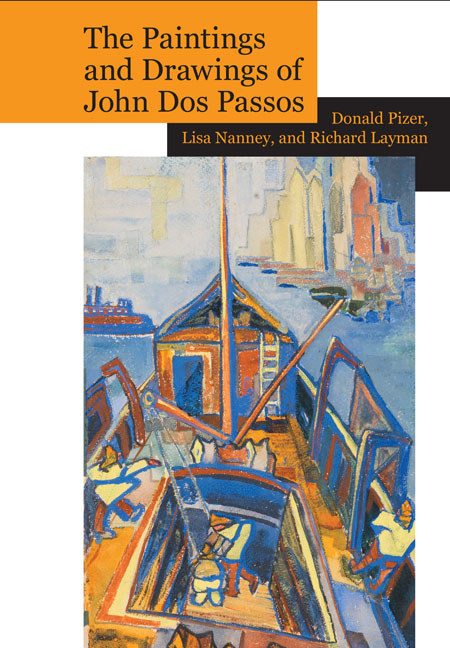Book contents
- Frontmatter
- Contents
- Preface
- Acknowledgments
- The Paintings and Drawings of John Dos Passos: A Collection and Study
- Introduction
- Paintings and Drawings Included in this Volume: A Descriptive List
- Preface to Section 1: Early Work 1918–20
- Preface to Section 2: The Middle East and Morocco 1921–22, 1926
- Preface to Section 3: Paris 1921–25
- Preface to Section 4: New York 1920–24
- Preface to Section 5: New York: Nudes 1920–23
- Preface to Section 6: Theater Designs 1925–28
- Preface to Section 7: Mexico 1926–32
- Preface to Section 8: Later Work 1930–70
- Preface to Section 9: Portraits
- Preface to Section 10: Sea Fronts and Harbors
- Preface to Section 11: Still Lifes
- Preface to Section 12: Studies in Motion
- Preface to Section 13: Abstractions and Other Experimental Modes
- Words and Images: The Visual Art of John Dos Passos
- The Artwork of John Dos Passos
- Notes
- Works Cited
- Index
- Plate section
Preface to Section 13: Abstractions and Other Experimental Modes
from The Paintings and Drawings of John Dos Passos: A Collection and Study
- Frontmatter
- Contents
- Preface
- Acknowledgments
- The Paintings and Drawings of John Dos Passos: A Collection and Study
- Introduction
- Paintings and Drawings Included in this Volume: A Descriptive List
- Preface to Section 1: Early Work 1918–20
- Preface to Section 2: The Middle East and Morocco 1921–22, 1926
- Preface to Section 3: Paris 1921–25
- Preface to Section 4: New York 1920–24
- Preface to Section 5: New York: Nudes 1920–23
- Preface to Section 6: Theater Designs 1925–28
- Preface to Section 7: Mexico 1926–32
- Preface to Section 8: Later Work 1930–70
- Preface to Section 9: Portraits
- Preface to Section 10: Sea Fronts and Harbors
- Preface to Section 11: Still Lifes
- Preface to Section 12: Studies in Motion
- Preface to Section 13: Abstractions and Other Experimental Modes
- Words and Images: The Visual Art of John Dos Passos
- The Artwork of John Dos Passos
- Notes
- Works Cited
- Index
- Plate section
Summary
The body of Dos Passos's visual work contains few abstractions. The small number he did produce, such as figures 62 and 63, seem to be explorations of the extreme potentials of an aesthetic or medium in which he was involved at the time. These two gouaches were probably executed in New York in the mid-1920s while he was painting seriously, showing his paintings, and creating stage designs for the New Playwrights’ Theater. Many of those sets and backdrops (figs. 30–35) combine modernist aesthetics—Expressionist color, Precisionist formal dynamics, Cubist compositional elements—innovatively for the purpose of immersing the playgoer in the rhythms and dissonances of American urban life and work. But despite Cubist fragmentation of their subjects, they do include naturalistic elements of the city setting—train and railroad tracks, industrial smokestacks, skyscrapers, building girders, bill-boards, and signs.
Abstractions 62 and 63 use the saturated palette, thick gouache, and loose colliding compositional forms of these stage sets but depart entirely from the representational. They isolate and analyze the underlying dynamics Dos Passos employed in the much larger designs for the theater. Figure 62, a somewhat more static composition than figure 63, opposes jagged planes of red, green, and blue in close tension, in the same way he juxtaposed planes of buildings and other urban structures in the stage designs. By outlining the segments of the abstraction in definitive black paint, Dos Passos contributes to the solidity of the elements. In figure 63 he creates circular compositional elements and outlines them mostly in white or yellow, creating a lighter, more fluid dynamic. The rolling motion and vivid reds and blues in this abstraction recall the aggressively colored mobility of the rounded letters in the name of John Howard Lawson's experimental play, Processional (1925), for which Dos Passos created the poster in figure 35.
In their complete departure from representationalism, these two abstractions convey the interest in the interaction of pure form and color that was the hallmark of early abstractions by American painters such as Arthur Dove and Georgia O'Keeffe, both featured in independent shows at Stieglitz's 291 gallery around the time of the 1913 Armory Show that introduced America—and Dos Passos—fully to European modernism.
- Type
- Chapter
- Information
- Publisher: Liverpool University PressPrint publication year: 2016



